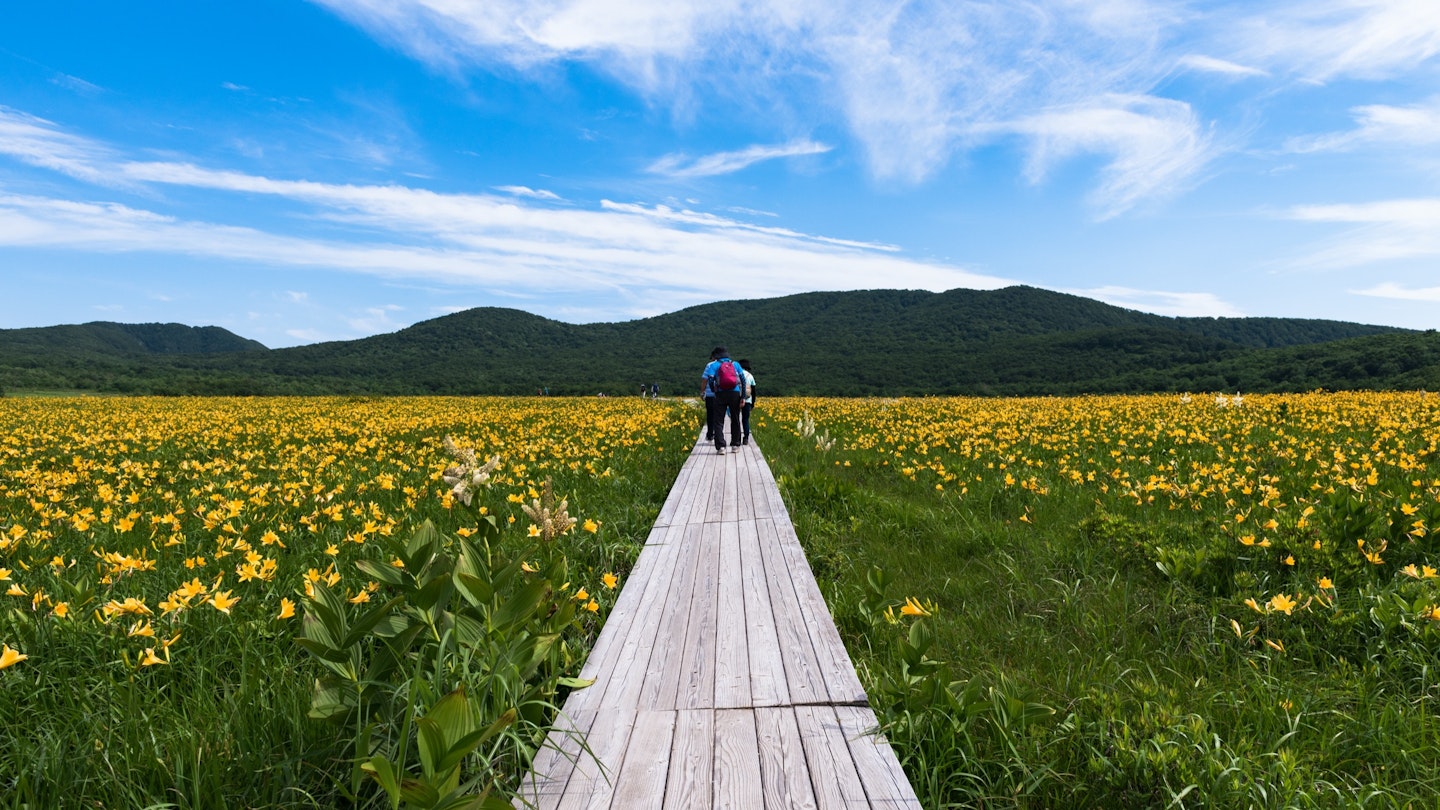Bandai-Asahi National Park, stretching across Japan’s Tohoku and Hokuriku regions, is a fusion of the contrasting elements which underpin Japanese nature and culture.
A ritual of mountain worship that has been passed down for 1,400 years coincides with modern amenities like QR guides and visitor centers. The park is home to imposing mountain ranges and simmering volcanoes which rub shoulders with placid ponds, wildlife, and delicate flora. In the summer, Bandai-Asahi glows in brilliant shades of emerald-green while birds chortle in the overhead boscage; however, in the snowy winters, it becomes a silent if pristine world.
Read on to find out more about the stunning contrasts of Bandai-Asahi National Park:

Nature on the Doorstep
Bandai-Asahi National Park straddles the border of three prefectures: Yamagata, Fukushima, and Niigata. Consequently, while its rolling forests and lake-dotted parkland epitomize the bucolic nature of rural Japan, it’s also close to several of the major population centers in northern Honshu (Japan’s main island).
Fukushima City, capital of its namesake prefecture, is famous for its nihonshu (sake), peaches, apples, and the art of bonsai. Just over an hour by car from the city center, you’ll be at the foot of Mt. Bandai, which features many lakes and ponds formed by the 1888 eruption and collapse of the mountain.
Yonezawa in Yamagata Prefecture, a city of centuries-old onsen (hot spring) resorts, flirts with the borders of the national park. Meanwhile, the lively Niigata City, one of northern Japan’s largest metropolitan areas and home to the stone Bandai Bridge (designated as an Important Cultural Property in 2004), is less than two hours from the park by car. The six-arched, granite-sided bridge was constructed in 1929 and remains one of the most scenic spots in the city, especially when illuminated at night.
Mountains and Flowers
Whether it’s the spiritual peaks of Dewa Sanzan (the three mountains of Dewa), the volcanoes of the Bandai-Azuma district, or the non-volcanic Iide Mountains running along the spine of the three prefectural borders, Bandai-Asahi National Park abounds in grandiose scenery. Carving through the mountains in the Dewa Sanzan are well-defined hiking trails lined by Shinto shrines and spiritual iconography, all of which are accessible in spring and summer.
Contrasting the dramatic mountain vistas are myriad species of flower; the kinds you might observe on poetic ukiyo-e woodblock art—a popular craft during the Edo Period (1603–1868).
In the north of Bandai-Asahi, you’ll find hemerocallis dumortieri, or daylilies, which look similar to flowering lilies. Near the summit of Mt. Iide, you’ll discover Iiderindo, five-petaled flowers that take on a dusky blue hue when in full bloom. The Asahi Mountain Range, which divides Yamagata and Niigata Prefectures, is home to the large, pink trumpet petals of lilium rubellim. In the summer, Urabandai’s ponds are abundant with pygmy water lilies and edible green junsai plants.

Fire and Water
Typically, fire and water don’t make the best of friends. However, in the Urabandai section of Bandai-Asahi National Park, they’ve combined to craft a rather striking landscape. Bandai-san’s steam and pyroclastic eruption of 1888 killed almost 500 people and rendered thousands more homeless. At the same time, the obliteration of the volcano’s conical wall and the resulting rock avalanche redirected rivers, hiding hundreds of square miles of forest under ponds. More than a century later, we can now appreciate this new topography via the park’s walking trails.
The Goshikinuma nature trail takes you past a series of colorful volcanic lakes, each with its own distinct color, from one that’s a milky lime to another that’s a vivid shade of turquoise. The Rengenuma pond trail in Urabandai offers scintillating views of the collapsed Mt. Bandai, its sister peak Mt. Kushigamine, and the forested plateau below. Alternatively, you can tackle the approximately 20-mile running and cycling track which traces the perimeter of the largest lake in the Urabandai district, Lake Hibara.
Old Meets New
Bandai-Asahi National Park’s most historically significant region is Dewa Sanzan, composed of the mountains of Haguro-san (representing birth), Gas-san (representing death), and Yudono-san (representing rebirth). Even after about 1,400 years of Shugendo yamabushi (mountain monks) cleansing their souls by hiking this group of sacred peaks, pilgrims from near and far still come to pay their dues and give votive offerings to Dewa Sanzan’s numerous shrines and temples.
Today, there are fresh new ways to connect with these remarkable mountains, streamlined with modern conveniences. Three visitor centers in Bandai-Asahi National Park built in tasteful, yet environmentally appropriate styles are scattered throughout the park. Signposted QR codes in the Urabandai district give on-the-ground guidance and provide GPS services to help navigate your forest sojourns. Moreover, there are hotels inside Urabandai where visitors can experience nature’s doorstep, such as Kyukamura Urabandai, a popular workation spot.

The Changing of the Seasons
Bandai-Asahi National Park changes dramatically with the seasons. The provincial forests, verdant highlands, and moss-smothered walking trails are blanketed in snow when winter descends upon northern Japan. Much of the wildlife— including Asiatic black bears, squirrels, foxes, and migratory birds—either hibernate or migrate to warmer climates, leaving behind a motionless white landscape. The Goshikinuma nature trail provides some of the best color-clashing scenery in winter, where powdery tufts of snow surround the vivid colors of the extraterrestrial-looking ponds.
Winter also heralds the end of summer outdoor activities, which include cycling, hiking, and kayaking, paving the way for several months of winter outdoor activities. Alts Bandai, Inawashiro, and Grandeco are among the most popular ski resorts in the Urabandai region, catering to various inclinations and levels of ability. Snowshoe trekking and Japanese pond smelt fishing are also popular within Bandai-Asahi National Park during winter.
For more information, visit Bandai-Asahi National Park on the National Parks of Japan website.




